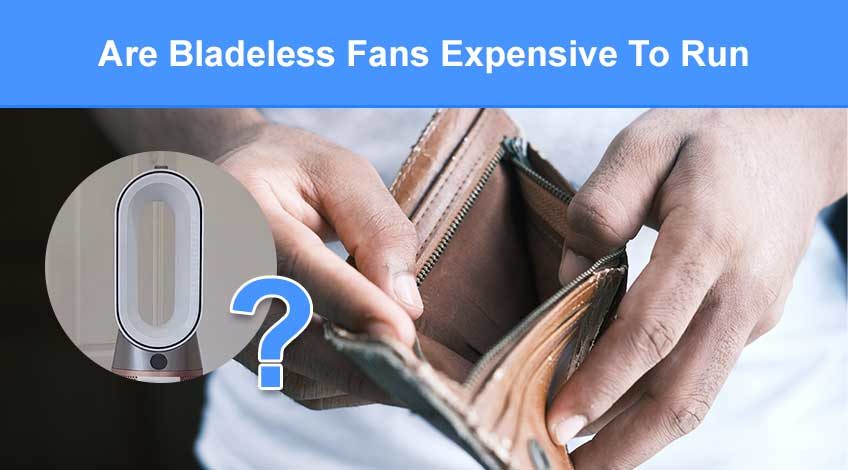
Are Bladeless Fans Expensive To Run? (do they use less power)
Bladeless fans are the new must have product that’s been hitting the electrical appliance market in recent years. There are many pages of articles telling of the benefits and superiority of bladeless fans over comparable regular fans. But are they expensive to run? And how does power consumption compare to conventional fans?
If you want to know the answers to these questions, keep reading.
How Much Does It Cost To Run A Bladeless Fan?
There’s no doubt that bladeless fans look cool, however, they cost considerably more than a regular fan. So is some of that cost offset through lower energy bills?
Most bladeless fans use less electricity than regular fans of a comparable size. In fact, most bladeless fans not only use less energy than conventional fans of a comparable size, they also push far more air into the room as well.
But to find out exactly how much it actually costs to run a bladeless fan is going to take a quick maths lesson.
How To Work Out How Much Electricity The Fan Is Using
To find out how much it costs to run a bladeless fan you’ll need to find out how much electricity it’s using. To find this out you need to find out the wattage of the fan. This will either be on the box or instruction leaflet or it can be found online.
Once you have the wattage, you need to divide it by 1,000 to convert it into kilowatt-hours. For example; a 50 watt fan uses 0.05 Kw because 50 ÷ 1000=0.05 Kw.
To calculate how much it costs to run, just multiply the Kw by the cost of one unit of electricity (which can be found on your electricity bill). If your electricity costs 34p per unit it would mean the fan costs 13.6p to run for 8 hours (because 0.05 x 34 x 8 = 13.6).
This calculation works for all electrical appliances so you might want to make a note of it (maybe save this article to favourites for future reference).
Running Cost Price Comparison

Let’s look at a few more examples, we’ll take a regular fan, a tower fan and a bladeless fan and compare the cost of each.
Regular Fan Running Costs
Let’s look at an 18 inch bladed floor fan which uses 110 watts when running at full power. Using the same formula as before, 110 ÷ 1000 = 0.1 Kwh which would mean using the same rate of electricity at 34p per unit this fan would cost 3.4p per hour or 27.2p for 8 hours because 3.4 x 8 = 27.2.
This means that a regular fan would cost just over 27p to use for 8 hours.
Bladeless Fan Running Costs
How about our bladeless fan which uses 56 watts or 0.056 kWh. This means it would cost 1.9 p per hour or 15.2 p for 8 hours because 0.056 x 34 =1.904 and 1.904 x 8 =15.232
This means that a bladeless fan costs just over 15p for 8 hours.
Tower Fan Running Costs
Then there’s a tower fan that uses 35 watts or 0.035 kWh which uses just over one penny per hour or 0.035 x 34 = 1.19p or around 9.5 p for 8 hours.
This means that a tower fan costs just over 9p for 8 hours
As you can see the conventional fan is the most expensive to run, followed by the bladeless fan, with the tower fan having the cheapest running costs.
SEE ALSO: Our Picks For The Greatest Bladeless Fans You Can Buy Today
What About Energy Efficiency?
The power of the motor used to run your fan is only half the story, it’s all very well running a fan for 8 hours for less than 10 pence but will it keep you as cool as the more expensive to run regular or bladeless fans?
Let’s look at the same 3 types of fan but look at energy efficiency;
Regular Bladed Fans
Bladed fans tend to use the most energy. This is because the larger the blade size, the more energy it takes to turn them.
Tower Fans
Tower fans usually have a lower power consumption than bladed fans. However, they tend to be less successful at pushing air which means you’ll need to use a higher setting (which uses more power).
Bladeless Fans
Bladeless fans tend to push far more air than either of the other fans. Also known as air multipliers, they draw air in at the base which collects air from outside of the top ring when it’s forced out.
The brand leader, Dyson, claims that there is up to 15 times more air produced through the ring than is drawn in through the base.
This means that bladeless fans are more energy efficient than conventional fans or tower fans.
So Are Bladeless Fans Expensive To Run?

As you can see from the above illustrations, bladeless fans are cheaper to run than conventional bladed fans. But they cost more to run than tower fans.
However, tower fans are less efficient at circulating air and also produce less airflow than bladeless fans.
So we’d have to say that even though bladeless fans aren’t the absolute cheapest to run, they do work out better value overall. Apart from the initial purchase price of course.
With that said, due to their innovative design, bladeless fans do have a longer life expectancy than a regular or tower fan as long as they are regularly cleaned of dust. For information on the correct way to clean a bladeless fan click here.
Ways To Cut The Running Cost Of Your Fan
If, after calculating how much your fan is costing you to run, you want to make a saving on the running cost and keep your energy bill lower, keep reading. We have a few suggestions to help save those pennies.
Never Leave A Fan Running In An Empty Room
Despite popular opinion, a fan does not cool a room, only air conditioners (A/C’s) do that. A fan moves air at room temperature and directs it at speed towards the person in the room.
That air then passes over the person’s skin and speeds up the evaporation of sweat. It’s that evaporation of sweat that makes the person feel cooler. So if there’s nobody in the room, there’s no point leaving the fan turned on.
The only exception to this is if your bedroom is extremely hot from catching the sun all day. Once the evening comes and the air is cooler, it is worth running a fan by an open window to allow cooler air to be drawn into the room.
This can be left running for an hour or so before you retire for the evening.
Place A Bowl Of Ice In Front Of The Fan
Instead of turning the fan onto a higher setting, place a bowl of ice in front of the fan and allow the fan to blow cold air (and ice cold water droplets) towards you.
This will make the air temperature cooler in front of the fan and therefore make you feel cooler too.
Keep The Curtains Closed On Sunny Days
By keeping the sunlight from the room, you can prevent up to 30% of unwanted heat in the room. This works particularly well in bedrooms or other rooms that are not used during the day.
Keep The Fan Dusted
All fans draw in dust as they operate and to keep them running at their best, they need regular cleaning to remove that dust. This is because dust can slow the fan’s blades down which puts added pressure onto the motor.
If the motor is struggling, it will be using the same amount of energy to produce less power. Or more energy to turn the blades at the speed they were designed to run at.
Either way your fan will be less efficient if it’s covered in dust.
Plus for asthma and hay fever sufferers, extra dust can be a nuisance at best and life threatening at worst.
SEE ALSO: Are Bladeless Fans Better Than Regular Fans? (pros & cons)
Do You Have Any Questions?
We hope you found this article helpful, if you have any questions drop them in the comments below.
Frequently Asked Questions
Bladeless fans use far less electricity than regular bladed fans. The average cost of running a bladeless fan is around 2p per hour assuming your electricity supplier charges 34p per unit. A comparable bladed fan would cost around 3.4p per hour at the same rate.
Due to their innovative design, bladeless fans are far more energy efficient than comparable bladed fans. They work on the principle of sucking air in and forcing air out which is a simple mechanism. This means they do not consume a lot of electricity and are energy efficient.
It is worth buying a bladeless fan because they are designed to look aesthetically pleasing, they’re safer for using around children, easy to clean and they’re more energy efficient as well.
Dyson bladeless fans cost around 2p per hour to run in the UK assuming your electricity supplier charges 34p per unit. A Comparable bladed fan would cost around 3.4p per hour at the same rate. Which means a Dyson bladeless fan is cheaper to run than a bladed fan.




